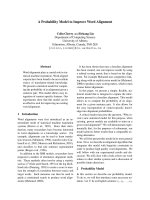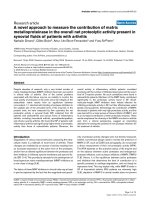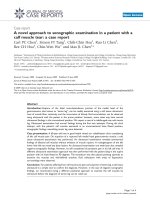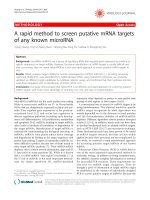Báo cáo y học: " A mouse model to study infection against porcine circovirus type 2: viral distribution and lesions in mouse" docx
Bạn đang xem bản rút gọn của tài liệu. Xem và tải ngay bản đầy đủ của tài liệu tại đây (914.72 KB, 6 trang )
RESEARC H Open Access
A mouse model to study infection against
porcine circovirus type 2: viral distribution
and lesions in mouse
Jun Li
1,2,3†
, Xiaoyuan Yuan
1,2
, Chaofan Zhang
3
, Lanfei Miao
3
, Jiaqiang Wu
2
, Jianli Shi
2
, Shaojian Xu
2
, Shangjin Cui
3*
,
Jinbao Wang
1,2*
, Hongbin Ai
1*
Abstract
Background: Little information is kno wn about viral distribution and transmission of porcine circovirus type 2 (PCV2)
in species other than swine. It is still a debated topic whether the PCV2 could be infected and caused clinical lesions.
Our study is aimed to esti mate the susceptibility of Kunming mouse to PCV2. Forty-eight, 6-week-old Kunming mice
were randomly divided into four groups. Gro up A (C1-C12) was inoculated with PK-15 cell culture as a control group.
Group B (sPCV1-12) was inoculated orally and intramuscularly with PCV2 (10
6.2
TCID
50
/ml). Group C (mPCV1-12) was
inoculated orally and intramuscularly with PCV2 (10
6.2
TCID
50
/ml) and a booster inoculation at days 14 and 28 after
the first inoculation. Group D (MixPCV1-12) was unvaccinated but released into Group C. Each group was sacrificed at
7, 14, 28, and 42 days post-inoculation, respectively. Necropsy was checked on every mouse. Sera samples were
collected for the test of PCV2 specific antibody. Tissues were collected for histopathology study and polymerase
chain reaction (PCR).
Results: The results showed that viral replication, seroconversion, and microscopic lesions were found in
inoculated mice. Continuous existence of PCV2 viruses in lymph nodes have been confirmed by PCR, which took
at least seven days for the virus to be transferred into other organs from the primary interface, and the diffusion to
thymus had been retarded for seven days. Special PCV2 antibody could be found in PCV 2 inoculation mice and
was significantly higher than that in the control. Further more, microscopic lesions and the main target of PCV2
focused in the lymph nodes with a characteristic depletion and occasional necrosis of lymphocytes in the cortex
and paracortex were found in inoculated mice.
Conclusions: The Kunming mouse could be infected by PCV2 virus and used as a PCV2 infected experimental
model.
Background
Porcine Circovirus (PCV), a member of genus Circovirus
of the Circoviridae family, was first isolated as a non-cyto-
pathic contaminant of a porcine kidney cell line (PK-15)
and has been characterized as a small icosahedral DNA
virus [1-3], which was the pr imary causative agent of an
emerging swine disease- postweaning multisystemic
wasting syndrome (PMWS) [4]. The clinical signs were
characterized by progressive weight loss, dyspnea, tachyp-
nea and icterus in post-weaned pigs of approximately 8-12
weeks of age [5]. Gross lesions in pigs with PMWS consist
of generalized lymphadenopathy in combination with less
frequent lesions in the lungs, liver, kidneys and stomach
[6]. The most consistent microscopic lesions i n affected
pigs are in lymphoid organs a nd in clude lymphoid cell
depletion and glaucomatous inflammation with inconsis-
tently occurring intracytoplasmic viral inclusion bodies in
macrophages.
Recently, PCV2 disease has become a major immuno-
suppression problem for large-scale pig farms and caused
a great economic loss worldwide [7]. But, it is still difficult
* Correspondence: ; ;
† Contributed equally
1
College of Life Sciences, Key Laboratory of Animal Resistance of Shandong
Province, Shandong Normal University, Jinan, 250014, China
3
Division of Swine Infectious Diseases, State Key Laboratory of Veterinary
Biotechnology, Harbin Veterinary Research Institute of Chinese Academy of
Agricultural Sciences, Harbin, 150001, China
Li et al. Virology Journal 2010, 7:158
/>© 2010 Li et al; licensee BioMed Central Ltd. This is an Open Access article distributed under the terms of the Creative Commons
Attribution License ( which permits unrestricted use, distribution, and reproduction in
any medium, provided the original work is properly cite d.
to copy the clinical and patholo gic features of PMWS in
lab. Clinical PMWS had been reproduced in gnotobiotic
pigs co-infected with PCV2 and porcine parvovirus (PPV)
[5,8], however, no clinical PMWS found in gnotobiotic
pigs for just being infected with PCV2 alone [8,9].
Whether PCV2 can infect mice or other mammalian spe-
cies is still a debated topic. Kiupel [10] succeed in an
experimental model in BALB/c mice, but Quintana [11]
indicated that the PCV2 can’t replicate in mice. The aim
of this study was to make sure whether PCV2 could repli-
cate and distribute in Kunming mouse.
Results
Distribution of PCV2 in different organs clarified by
polymerase chain reaction
The fresh tissues of heart, liver, spleen, lung, kidney,
thymus, lymph node, jejunum, ileum, cecum, colon, ton-
gue and brain of each mouse were supplied for PCR. As
illustrated in T able 1, at day 7, the PCV2 was detected
in each tissue of sPCV and MixPCV mice except thy-
mus, tongue and brain. At day 14, the virus could be
detected in thym us, but the kidney was negative. The
PCR results of PCV2 in other tissues were the same to
that of d ay 7. At day 28, the virus could only be found
in the thym us and lymph node. At day 42, PCV2 still
coul d be found in the lymph node while its existence in
other tissues was not obvious. The cPCV mice were
negative, thoughout of the experiment. The above data
implied that there was viral replication in the PCV2
inoculation mouse groups.
The results of necropsy
Throughout the experiment, all of the mice survived
under the PCV2 inoculation and no clinical syndrome
was observed on cPCV, sPCV, or MixPCV mice. No
gross lesion was found i n cPCV, sPCV, or MixPCV
mice. In contrast, 8 of 12 mPCV mice had obvious intu-
mesce in the lymph node. 1 of 12 mPCV mice had
obvious intumesce in the spleen. There were no other
lesions found in other tissues.
Results of seroconversion antibody to PCV2
The anti-PCV2 special antibody level was evaluated by
ELISA. As shown in Figure 1, at day 7, seroconversion
to PCV2 can be found in 3 of the mice sacrificed in all
PCV2 inoculation groups and the MixPCV g roup. The
special antibody level was stead y for 42 days at least. In
mPCV mice, the antibody level was significantly higher
than that in sPCV mice and MixPCV mice (P<0.05).
The special antibody level of sPCV mice and MixPCV
mice was significantly higher than that in cPCV mice
(P<0.05). Antibody levels of all PCV2 inoculation
groups and the MixPCV group were significantly higher
than that in cPCV mice (P<0.05). In contrast, only
background levels of antibody responses were detected
in cPCV mice. The results implied that special PCV2
antibody can be found in PCV2 inoculation mouse
groups.
Histopathological results
The lesions of PCV2 infection w ere concentrated in the
lymph node. As shown in Figure 2, appar ent necrosis of
lymphocyte could be found in the lymphaticus of sPCV
mice, while some of the lymphocytes disappeared with a
vacuolus remaining. In mPCV mice, the necrosis of lym-
phocyte was more serious than those in sPCV mice.
Some of the lymphocyte was substituted by fibrosis.
In all of the PCV2 inoculated mice, the structure o f
alveolus was obvious. No collapse or exudation was
found in the alveolus cavity, but thrombus was depos-
ited on the walls of veins in sPCV and mPCV groups
(Figure 3). There was infiltration of lymph cells and
severe vasculitis of liver in mPCV mice. In contrast the
inflammation was not very serious, with only slight infil-
tration of lymph cells for liv er in sPCV mice (Figure 4).
In the spleens of sPCV mice, the necrosis and absence
of lymph cells in lymph nodes was found. In mPCV
mice, the disintegrat ion of lymph cells can be seen in
the spleen (Figure 5). There was no obvious change in
Table 1 Distribution of PCV2 in sPCV at Different Time
Time Heart liver spleen lung kidney thymus lymph node
day 7 +++ +++ +++ +++ +++ - +++
day 14 +++ +++ +++ +++ - ++ +++
day 28 - - - - - +++ +++
day 42 - - - - - - +++
+: one positive result, ++: two positive results, +++: three positive results, -:
negative result
Figure 1 Identification of special antibody of PCV2 for cPCV,
sPCV, mPCV and MixPCV mice. X-axis represents the value at
optical densities (OD630nm), Y-axis represents the days PI. Different
letters “a”, “b”, and “c” represent significance. The level of
significance was set at P < 0.05.
Li et al. Virology Journal 2010, 7:158
/>Page 2 of 6
other tissues, so the figures were not attached. The
above data implied that PCV2 could cause lesions on
the Kunming mouse and pathological changes were
focused in the lymphatic organ, spleen, lung and liver.
Discussion
To date, limited information was available on the host
rangeofPCV2,butantibodieswerefoundinvarious
species other than pigs, inclu ding humans, mice, and
cattle [11,12]. Whether PCV2 can cause clinical lesions
in a mouse is still a debated topic. Therefore, Kunming
mouse were chosen as the experimental animal for our
research. Results of this study demonstrate that PCV2
can replicate in Kunming mouse.
Kiupel [10] demonstrated that PCV2 was capable of
replicating in BALB/c mice and caused microscopic
lesions, which were similar to that of PCV2 infection in
pigs. In contrast, Quintana [13] reported that no micro-
scopic lesions compatible with PCV2 infections were
detected in inoculated mice, but it was considered to be
due to the dosage of the inoculums and administration
route. The multi-route and large doses of injection were
adopted in this experiment. In this study, viral replica-
tion, seroconversion, and microscopic lesions were char-
acterized in inoculated mic e. Continuous existence of
virion in the lymph node has been confirmed by PCR.
Necropsy results shown that 66.7% mPCV mice had
obvious intumesce in the lymph node. One mPCV
mouse had obvious intumesce in the spleen. Ther e were
no other lesions found in other tissues. The results are
as well as those obtained by Kiupel [10], who found
some evidence of PCV2 replication in tissues of BALB/c
mice. The same conclusion can be replicated in different
mice with different PCV2 iso lates and viral inoculation
as in this study (date not shown).
The ability of PCV2 to infect [4] and cause lesions in
pigs was demonstrated previous ly in experimentally
infected pigs [14]. In affected lymph nodes from i nocu-
lated piglets, marked expansio n of cortical and p aracor-
tical zones, with infiltration by cells of monocyte/
macrophage morphology, w as found. Depletion and
occasional necrosis of lymphocytes is a characteristic
Figure 2 Pathological section for lymph node. A: Normal lymph node. B: Lymph node from sPCV-inoculated mouse, 28 days PI. Necrosis for
lymphoid nodule and present vacuolus (arrows). C: Lymph node from mPCV-inoculated mouse 42 days PI. Necrosis for lymph node and low-
grade fibrosis (arrows). HE staining, ×200.
Figure 3 Pathological section for lung. A: Normal lung. B: Lung from sPCV-inoculated mouse 28 days PI. Thrombus for lung (arrows). C: Lung
from mPCV mouse, thrombus and inflammation in veins. HE staining, ×200.
Li et al. Virology Journal 2010, 7:158
/>Page 3 of 6
result after PCV2 infection. In this study, we also found
that the distribution and lesions of PCV2 infection has
an obvious regularity. First, it has taken at least 7 days
for the PCV2 to be transferred into other organs from
the primary interface. It seems that the diffusi on to thy-
mus had been retarded for 7 days. The replication of
PCV2 can be continually detected in the lymph node
until the end of the experiment, which was in accord
with those by the piglets. Second, we found that PCV2
could make microscopic lesions on the mouse such as
lymphatic organ, spleen, lung and liver. The main target
of PCV2 in t he mouse was focused in the lymph node,
with a characteristic depletion and oc casional necrosis
of lymphocytes in the cortex and paracortex. Overall in
mPCV mice, microscopic lesions were more serious
than those in sPCV mice. There was infiltration of
lymph cells and severe vasculitis of liver in mPCV mice.
In contrast the inflammation was not very serious, with
only slight infiltration of lymph cells for li ver in sPCV
mice. In the spleens of sPCV mice, the necrosis and
absence of lymph cells in lymph nodes was found. In
mPCV mice, the disint egration of lymph cells can be
seen in the spleen. We could get a conclusion that
PCV2 could cause lesions in Kunming mouse which
were similar t o that of Kiupel reported[10] and more
and more seriously with the PCV2 increasing. However,
the mechanism of PCV2 induced damage on lympho-
cytes and spleen is not clear, it was need to test in
further study and discussion.
The anti-PCV2 special antibody can be found in PCV2
inocu lation mouse groups and was steady for 42 days at
least. The results of seroconversion antibody to PCV2
were another evidences to the conclusion that PCV2
could replicate in Kunming mouse.
Conclusions
In summary, viral replication, seroconversion, and micro-
scopic lesions have been determined in inoculated mice,
and the persistent existe nce of PCV2 in the lymph were
also confirmed by PCR, which suggest that the Kunming
mouse can be infected by PCV2, and used as a PCV2
infected experimental model.
Figure 4 Pathological section for liver. A: Normal liver. B: L iver from sPCV mouse, infiltration of lymph cells. C: Liver fro m m PCV-inoculated
mouse 42 days PI. Necrosis, infiltration of lymph cell, and severe vasculitis for liver (arrows). HE staining, ×200.
Figure 5 Pathological section for spleen. A: Normal spleen. B: S pleen from sPCV mouse, necrosis and reduction of lymph cells in lymph
nodule. C: Spleen from mPCV-inoculated mouse, necrosis of lymph cells and low-grade disintegration (arrows). HE staining, ×400.
Li et al. Virology Journal 2010, 7:158
/>Page 4 of 6
Materials and met hods
Virus, Cells and cell culture
The PCV2 virus stra in SD2(DQ478947) was propagated
in PCV1-free porcine kidney 15 (PK-15) cell lines, main-
tained in RPMI medium 1640 supplied with 10% fetal
calf serum. The inoculums contained 1 × 10
6.2
infectious
viruses per millilitre when titrated on a PCV-free PK-15
cell monolayer.
Animal experiment
Forty-eight 6-week-old Kun ming mice w ere purchased
from the experimental animal centre of Harbin Veterin-
ary Research Institute of Chinese Academy of Agricul-
tural Sciences. Mice were ma intained in isolation rooms
in filter top cages and any handling and husbandr y pro-
cedures were performed under a laminar flow hood.
The experimental animals were randomly divided into
four groups. Grou p A (cPCV1-12) was inoculated with
PK-15 cell cul ture of RPMI medium 1640 at days 1, 14,
and 28 post inoculation as the control group. Group B
(sPCV1-12) was inoculated orally and intramuscularly
with 0.1ml PCV2 (10
6.2
TCID
50
/ml) at day 1. Group C
(mPCV1-12) was inoculated orally and intramuscularly
with 0.1ml PCV2 (10
6.2
TCID
50
/ml) at day 1 and with a
booster inoculation at days 14 and 28 post first inocula-
tion. Group D (MixPCV1-12) was unvaccinated but
released into Group C at day 1. The condition of the
mice was recorded every day.
Necropsy and histopathological analysis
Three mice from each group were killed by bleeding at
days 7, 14, 28, and 42 respectively and the sera were
collected. Any gross lesions at necropsy were recorded.
Fresh heart, liver, spleen, lung, kidney, thoracic gland,
lymph node, dodecadactylon, jejunum, ileum, caecum,
colon, rectum, tongue and brain of each mouse were
collected. Tissues with evide nt lesions were fixed in
10% neutral buffered formalin. Fixed tissues were
dehydrated in a series of alcohols, cleared in xylene,
and embedded in paraffin. Sections were stained with
hematoxylin and eosin and then were observed under
a l ight microscope.
Detection of PCV2 by polymerase chain reaction
A pai r of primers was designed based on the published
sequences of PCV2 (upstream primer, 5′ -AAGGGC
TGGGTTATGGTATG-3′ ; downstream primer, 5′ -
CGCTGGAGAAGGAAAAATGG-3′).
The genome DNA of PCV2 was extracted with a pre-
viously reported method [15]. After being freezed and
thawed three times, 0.1 g of the tissues (heart, liver, spleen,
lung, kidney, thymus, lymph node, jejunum, ileum, cecum,
colon, tongue and brain) were homogenized with a
homogenizer. 500 μL of the samples were digested with
1 μL of proteinase K (Sigma) and then incubated at 50°C
for 1.5 hours. The digestion samples were extracted with
equal volume of phenol-chloroform (1:1 v/v). After centri-
fuged at 12,000g for 15 minutes, the upper layer was
transferred to new Eppendorf tubes. 200 μLofisopro-
panol was added to each tube, which were then incu-
bated at -20°C for 1 hour. This was followed by
centrifugation at 12,000 g for 10 minutes. Then the
supernatant was discarded and the pellet was washe d
once with 75% ice-cold ethanol, after which it was
dried in a laminar flow cabinet. T he precipitate of
DNA was dissolved in 50 μL of sterile water and then
stored in -20°C for later use.
PCR was carried out in a 50 μL reaction volume con-
taining 4 μL of dNTP mixture (2.5mmol/L), 5 μL of 10×
PCR buffer, 5 U of Taq polymerase (TaKaRa Company),
10 μM each of primers, 33.5 μLH
2
Oand1μL of preci-
pitate DNA extracted previously. PCR was performed as
follows: 94°C for 5minutes followed by 30 cycles of 94°C
for 45 seconds, 56°C for 30 seconds, and 72°C for 30 sec-
onds, with a final extension step for 7 minutes at 72°C.
The PCR was carried out in the 2720 Thermal Cycler
(Applied Biosystems). PCR products were subjected to
electrophoresis on a 1% agarose gel.
Enzyme-linked immunosorbent assay for antibody level
Theserafromexperimentalanimalswerehandled
according to a previous reported method [10]. Sera col-
lected from cPCV, sPCV, mPCV, and MixPCV mice
were tested for special antibodies to PCV2 by Enzyme-
linked immunosorbent assay (E LISA). A commercial
ELISA kit bought from Green Spring Biotechnology
Company was used in this study. 100 μL of diluted sam-
ples (1:40, v/v) were added into each well and the plate
was incubated at 37°C for 30 minutes. After shaking out
the samples, washing each plate six times with 1×
TBST, and slapping the plate face down onto a clean
section of paper towel, 100 μL of HRP-conjugated anti-
mouse antibody were added t o each well and incubated
at 37°C for 30 minutes. Plates were washed six times
with Tris buffered saline with Tween 20 (pH 7.6). Sub-
strate solution was then added to each well, incubated
at room temperature for 10 minutes, after which the
optical density was read using a microplate reader set at
630 nm.
Statistical analysis
All data are presented as means ± SD with SPSS13.0
software (SPSS, Chicago, IL, USA). Statistical analyses
were performed by two-way analysis of variance
(ANOVA) followed by S-N-K posthoc tests individually.
The level of significance was set at P < 0.05.
Li et al. Virology Journal 2010, 7:158
/>Page 5 of 6
Acknowledgements
The study was partly supported by funds from the Chinese National Key
Laboratory of Veterinary Biotechnology Fund (SKLVBF201007and
NKLVBP200807), Natural Fund of ShanDong (Y2006D23), Shandong Provincial
scientific and technological project(2008GG10009034), Main and Special
Funds for New Breeds of genetically modified organisms (Grant
No.2009ZX08009-143B), the ShanDong Academy of Agricultural Sciences
Great Innovation Fund (2007YCX017-04) and the ShanDong Academy of
Agricultural Sciences Youth Fund (2006YQN033). The authors thank Ms. Sara
and Dr Zhuoming Qin for preparation of the manuscript.
Author details
1
College of Life Sciences, Key Laboratory of Animal Resistance of Shandong
Province, Shandong Normal University, Jinan, 250014, China.
2
Division of
Swine Diseases, Shandong Provincial Key Laboratory of Animal Disease
Control & Breeding, Institute of Animal Science and Veterinary Medicine
Shandong Academy of Agricultural Sciences, Jinan, 250100, China.
3
Division
of Swine Infectious Diseases, State Key Laboratory of Veterinary
Biotechnology, Harbin Veterinary Research Institute of Chinese Academy of
Agricultural Sciences, Harbin, 150001, China.
Authors’ contributions
JL, XY, CZ, LM, JW, JS, and SX carried out the experiments and wrote the
manuscript. SC, JW, and HA conceived the studies and participated in
experimental design and coordination. All authors read and approved the
final manuscript.
Competing interests
The authors declare that they have no competing interests.
Received: 13 May 2010 Accepted: 15 July 2010 Published: 15 July 2010
References
1. Tischer I, Rasch R, Tochtermann G: Characterization of papovavirus and
picornavirus-like particles in permanent pig kidney cell lines. Zentralbl
Bakteriol Hyg A 1974, 226:153-167.
2. Tischer I, Gelderblom H, Vettermann W, Koch MA: A very small porcine
virus with circularsingle-stranded DNA. Nature 1982, 295:64-66.
3. Pringle CR: Virus taxonomy at the XIth International Congress of
Virology, Sydney, Australia. Arch Virol 1999, 144:2065-2070.
4. Ellis J, Krakowka S, Lairmore M, Haines D, Bratanich A, Clark E, Allan G,
Konoby C, Hassard L, Meehan B, Martin K, Harding J, Kennedy S, McNeilly F:
Reproduction of lesions of postweaning multisystemic wasting
syndrome in gnotobiotic pigs. J Vet Diagn Invest 1999, 11:3-14.
5. Fenaux M, Halbur PG, Haqshenas G: Cloned genomic DNA of type 2
porcine circovirus was infectious when injected directly into the liver
and lymph nodes of pigs: characterization of clinical disease, virus
distribution, and pathologic lesions. J Virol 2002, 76:541-551.
6. Clark EG: Post-weaning multisystemic wasting syndrome. Proc Annu Meet
Am Assoc Swine Pract 1997, 28:499-501.
7. Yang HC: Eepidemic feature and restrain measures of immune inhibition
diseases in pigs. China Animal Husbandry and Veterinary Medicine 2004,
31:41-43.
8. Allan GM, Kennedy S, McNeilly F, Foster JC, Ellis JA, Krakowka SJ,
Meehan BM, Adair BM: Experimental reproduction of severe wasting
disease by co-infection of pigs with porcine circovirus and porcine
parvovirus. J Comp Pathol 1999, 121:1-11.
9. Allan GM, McNeilly F, Ellis J, Krakowka S, Meeham B, McNair I, Walker I,
Kennedy S: Experimental infection of colostrums deprived piglets with
porcine circovirus 2 (PCV2) and porcine reproductive and respiratory
syndrome virus (PRRSV) potentiates PCV2 replication. Arch Virol 2000,
145:2421-2429.
10. Kiupel M, Stevenson WG, Galbreath JE, North A, HogenEsch H, Mittal KS:
Porcine Circovirus type 2 (PCV2) causes apoptosis in experimentally
inoculated BALB/c mice. BMC Veterinary Research 2005, 1:7.
11. Quintana J, Segalés J, Rosell C, Calsamiglia M, Rodríguez-Arrioja GM,
Chianini F, Folch JM, Maldonado J, Doming M, Canal M, Plana-Durán J:
Clinical and pathological observations on pigs with postweaning
multisystemic wasting syndrome. Vet Re 2001, 149:357-361.
12. Nayar GP, Hamel AL, Linn L, Sachvie C, Grudeski E, Spearman G: Evidence
for circovirus in cattle with respiratory disease and from aborted bovine
fetuses. Can Vet J 1999, 40:277-278.
13. Quintana J, Segalés J, Calsamiglia M, Domingo M: Experimental inoculation
of porcine circoviruses type 1 (PCV1) and type 2 (PCV2) in rabbits and
mice. Vet Res 2002, 33:229-237.
14. Hines RK: Porcine circovirus causes congenital tremors type A-II proved
by fulfilling Koch’s postulates. PhD Diss
University of Georgia, Athens, GA
1994.
15. Sambrook J, Russell DW: Molecular Cloning: A Laboratory Manual. Cold
Spring Harbor Laboratory Press, New York, 3 2001.
doi:10.1186/1743-422X-7-158
Cite this article as: Li et al.: A mouse model to study infection against
porcine circovirus type 2: viral distribution and lesions in mouse.
Virology Journal 2010 7:158.
Submit your next manuscript to BioMed Central
and take full advantage of:
• Convenient online submission
• Thorough peer review
• No space constraints or color figure charges
• Immediate publication on acceptance
• Inclusion in PubMed, CAS, Scopus and Google Scholar
• Research which is freely available for redistribution
Submit your manuscript at
www.biomedcentral.com/submit
Li et al. Virology Journal 2010, 7:158
/>Page 6 of 6









